Water in Art
Professor Chris Witcombe
LEONARDO DA VINCI and WATER
A Sweet Briar College Learning Resource — Spring Semester 1999 |
Water in Art
Professor Chris Witcombe
LEONARDO DA VINCI and WATER
|
Leonardo da Vinci was fascinated by water.
 (image source) Leonardo, Old Man with Water Studies, c. 1513 For him it was full of paradox:
Leonardo described water as "the vehicle of nature" ("vetturale di natura"), believing water to be to the world what blood is to our bodies. As Leonardo understood it, water circulated according to fixed rules. It fell as rain or snow, springs from the ground, and runs in streams and rivers to the vast reservoir of the seas. Water is indispensable to humans, animals and plants, yet it can also be the instrument of their destruction. Its power is irresistible. Leonardo had witnessed great storms, and conducted numerous studies of the motion of water.
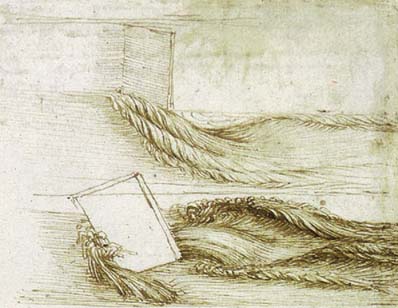 (image source) Leonardo, Study of water passing obstacles, c. 1508-9
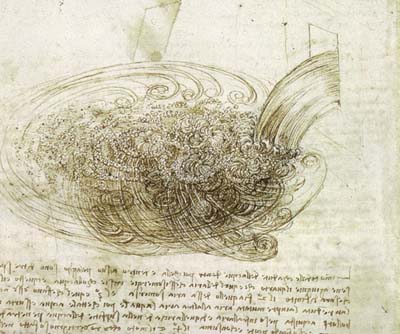 (image source) Leonardo, Study of water falling into still water, c. 1508-9
He examined the motion of waves and currents, and was the first to postulate the principle of erosion: "Water gnaws at mountains and fills valleys. If it could, it would reduce the earth to a perfect sphere" (Codex Atlanticus, 185v). Leonardo studied water also with the view to learning how to control it. Throughout his life, Leonardo was obsessed with a fear of a great watery cataclysm. In his drawings and in his writings he describes terrible floods and inundations and great storms.
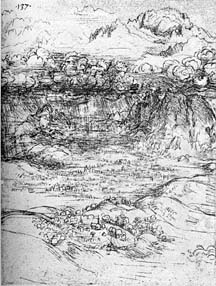 (image source) Leonardo, Storm over an Alpine Valley (Windsor, Royal Library, c. 1499)
His drawings indicate a special fear of swirling waters. There is nothing more terrifying, he felt, than a swollen river breaking its banks and sweeping people, animals, houses, trees, and even the land itself down into the sea. Leonardo had witnessed such disasters when the Arno river burst its banks on 12 January 1466, and again in 1478. Perhaps as a result of these events, and as a way of dealing with his fears, Leonardo devoted a lot energy to developing ways or devices to control and move water around water.
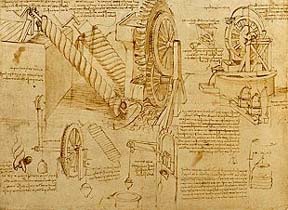 (image source) Leonardo, Machine for raising water (Codex Atlanticus, f. 26v) He also designed locks and canal systmes, and invented machines for excavating canals.
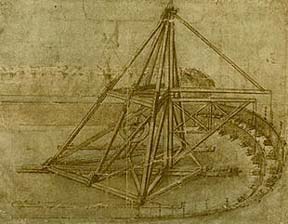 (image source) Leonardo, Machine for excavating canals (Codex Atlanticus, f. 4v) One large scale but never realized plan was for a navigable canal linking Florence to the sea. The scheme included cutting a series of giant steps with locks to enable ships to sail up into the hills. The water would be raised from one level to the next by a huge siphon. In Milan, he worked on a system of locks and paddle wheels for washing the streets. He also had plans for draining the unhealthy marshes of the Val di Chiana.
|
|---|
 CONTENTS
CONTENTS  INTRODUCTION
INTRODUCTION  PURPOSE
PURPOSE  SCHEDULE
SCHEDULE  REQUIREMENTS
REQUIREMENTS  PARTICIPANTS
PARTICIPANTS 
H20 - The Mystery, Art, and Science of Water
Chris Witcombe and Sang Hwang
Sweet Briar College